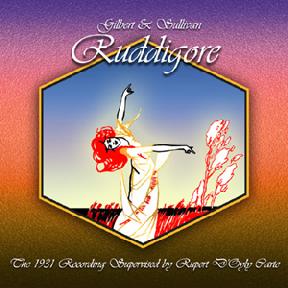The 1931 D'Oyly Carte Ruddigore
Conductor: Malcolm Sargent
Recorded 9 Sept. – 9 Nov. 1931 |
|
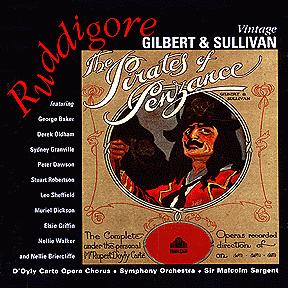 Happy Days CDHD 255/6 |
This was D'Oyly Carte's second recording of Ruddigore, following on the acoustically-recorded 1924 set. Three singers (Baker, Oldham and Fancourt) reprise their roles from the earlier set. Among those new to this set, Sydney Granville appears in one of his best roles, and Nellie Briercliffe, perhaps the greatest D'Oyly Carte soubrette ever, appears in one of the best women's parts in all G&S. A comparison of the two recordings shows that the pruning of Sullivan's score often attributed to Geoffrey Toye was in fact the work of more than one musical director. For example, "The battle's roar" is included on the earlier set, but excluded here.
Bruce Miller points out that it was published in America in July 1933, but "by the end of WWII it was removed from the main catalogue and relegated to the "Request" catalogue. Thus the relative scarcity of the US issue seems explained by its release in the worst year of the Depression and its early removal from the regular catalogue."
This recording was re-issued on LP by Arabesque. The re-issue fills out extra space on the second disc with excerpts from several of the earliest acoustical recordings, some of which have never been re-issued in any other form. It is a set worth having.
Chris Webster's CD re-issue is from original masters sourced at EMI's Abbey Road Studios.
Review by Chris Webster
 HMV Album Cover |
Wow. This really is a top class recording, and yet I had never realised it until quite recently. This is what comes about when you are always blowing hot and cold about an opera. I expect that when I have listened to it in the past it has been while Ruddigore has not been in my good books, but now that I have heard it during a period of liking Ruddigore I am really impressed.
This must surely be the best thing that Oldham ever did (certainly as far as G&S recordings go). His "I shipped, do you see" is a joy, and above all it is fun to listen to because you can hear that he is having fun singing it.
Unlike the Fancourt situation between the 26 and 36 Mikado recordings, where he is inferior in the second recording (although he does redeem himself in the 1950 set), Fancourt as Roderic is every bit as good here as he was in the acoustic recording. Perhaps he comes across even better because of the superior method of recording. Unfortunately though, the recording engineers messed up at the start of the second verse of "The Ghost's high noon" — they brought the mics down for the choral interjection at the end of verse one and were late bringing them back up again for the start of verse two (a minor point though).
I think that Robin Oakapple is a very difficult role to put across in music only, but here Baker manages it very well indeed, although not as well as Green did in 1950. Incidentally, on this occasion Baker does not replace Lytton, but replaces Green who had taken the role off Lytton in anticipation of Lytton's retirement.
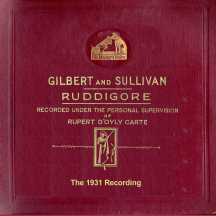 "78s 2 CD" GS10 |
Gill is quite acceptable in what I think can be pretty dull music unless the words are given their full potential. It takes a contralto of greatness to make Hannah's first song a top number, and good as she was, she was never as great as Bertha Lewis. Nevertheless her performance adequately puts things over and she is good to listen to.
I'm afraid I'm really not a fan of Muriel Dickson. To me, hers just isn't a G&S voice. She gets by with the music, and I know that others have a very strong liking for her, but she doesn't raise my temperature at all. For me this is something of a shame, because Rose can be such a good part on record, but I just don't think she has the extra something that is needed to pull the role off.
The lovely acoustic of Kingsway Hall and the spirit with which Sargent conducts, both help to lift a good cast to an even higher level and make this a winning recording.
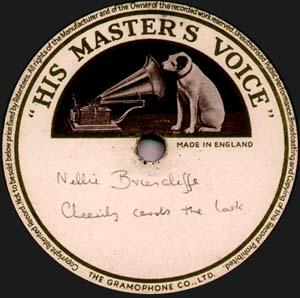 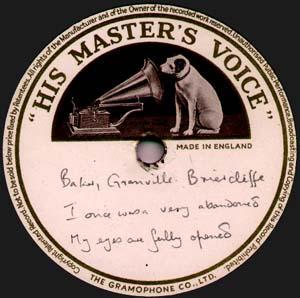 These are scans of the labels of Nellie Briercliffe's own single-sided test pressings of two sides from this recording. The matrices and takes are as published. Also surviving from her collection is one side from the 1928 Yeomen (which see). These precious relics were at some point given by Nellie to a British vicar who contacted Michael Walters and passed them on to him, who in turn has passed them on to Chris Webster. |
| Date | Label | Format | Number | Comments |
|---|---|---|---|---|
| 1931 | HMV | 78rpm | DB4005/13 in Album 143 | Manual side couplings |
| 1931? | HMV | 78rpm | DB7096/104 | Slide auto side couplings |
| July 1933 | RCA Victor | 78rpm | 11510/18 in Album C-19 | Manual side couplings |
| 11519/27 in Album AC-19 | Slide auto side couplings | |||
| 1940? | HMV | 78rpm | DB7522/30 | Drop auto side couplings |
| 1940 | RCA Victor | 78rpm | 13294/303 in Album DC-19 | Drop auto side couplings |
| 1985 | Arabesque | LP | 6548-2L | With acoustical excerpts, see below |
| Cassette | 7548-2L | |||
| 1986 | Sir Arthur Sullivan Society | Cassette | [unnumbered] | With miscellany |
| 1995 | Happy Days | CD | CDHD 255/256 | With 1929 Pirates |
| Cassette (not verified) |
CDHC 255/6 | |||
| 2000 | 78s 2 CD | CD | GS10 | |
| 2001 | Sounds on CD | CD | VGS 227 | |
| 2003 | Castle Pulse | CD | PBX CD 467 | With 1926 Mikado and 1927 Trial |
The acoustical excerpts on the Arabesque re-issue are from G&S recordings of the acoustical era and listed below:
| Recording | Selection | Artist(s) |
|---|---|---|
| 1924 Ruddigore | The battle's roar is over | Derek Oldham, Elsie Griffin |
| Sir Rupert Murgatroyd | Bertha Lewis | |
| There grew a little flower | Bertha Lewis, Darrell Fancourt | |
| 1924 Ida | Come, mighty Must | Bertha Lewis |
| Now wouldn't you like to rule | Eileen Sharp, Bertha Lewis | |
| Merrily ring the Luncheon Bell | Bertha Lewis, Leo Darnton | |
| 1922 Pinafore | My gallant crew, Good Morning | Sydney Granville |
| When I was a lad | Frederick Ranalow | |
| 1920 Pirates | When the foeman bares his steel | Peter Dawson, Violet Essex, Bessie Jones, George Baker |
| 1921 Patience | If you want a receipt | Peter Dawson |
| Prithee, pretty maiden | Frederick Ranalow, Violet Essex | |
| A magnet hung in a hardware shop | Frederick Ranalow | |
| 1922 Iolanthe | Go away, Madam | George Baker, Edna Thornton, Violet Essex |
| 1917 Mikado | The sun whose rays | Violet Essex |
| On a tree by a river | George Baker | |
| 1920 Yeomen | Rapture, rapture | Peter Dawson, Edna Thornton |
| O thoughtless crew! | George Baker, Violet Essex, Derek Oldham | |
| 1919 Gondoliers | Take a pair of sparkling eyes | Tudor Davies |
| Small titles and orders | George Baker, Edna Thornton |
| Side Nbr | Matrix Number |
Selection | Rec. Date |
|---|---|---|---|
| 1 | 2B1396-1A | Overture | 22 Sep 31 |
| 2 | 2B1453-1 | Fair is Rose as bright May-day | 9 Sep 31 |
| 3 | 2B1454-2 | Sir Rupert Murgatroyd | 9 Sep 31 |
| 4 | 2B1457-1 | If somebody there chanced to be | 9 Sep 31 |
| 5 | 2B1466-2A | I know a youth | 14 Sep 31 |
| 6 | 2B1471-1 | From the briny sea | 14 Sep 31 |
| 7 | 2B1455-1 | My boy, you may take it from me | 9 Sep 31 |
| 8 | 2B1465-1 | Cheerily carols the lark | 11 Sep 31 |
| 9 | 2B1460-2 | Welcome, gentry | 11 Sep 31 |
| 10 | 2B1463-1 | You understand? | 11 Sep 31 |
| 11 | 2B1468-1A | When the buds are blossoming | 14 Sep 31 |
| 12 | 2B1461-2A | Hold, bride and bridegroom | 11 Sep 31 |
| 13 | 2B1462-2 | Farewell! Thou hadst my heart | 11 Sep 31 |
| 14 | 2B1456-2 | I once was as meek as a new-born lamb | 9 Sep 31 |
| 15 | 2B1469-2 | In bygone days I had thy love | 14 Sep 31 |
| 16 | 2B1470-1 | When the night wind howls | 14 Sep 31 |
| 17 | 2B1464-3 | I once was a very abandoned person | 11 Sep 31 |
| 18 | 2B1467-4 | There grew a little flower | 9 Nov 31 |
Notes:
- Sides 5 & 7 were issued on EMI's A Tribute to George Baker
| Side Nbr | Matrix Number |
Selection | Rec. Date |
|---|---|---|---|
| 2 | 2B1453-1 | Fair is Rose as bright May-day | 9 Sep 31 |
| 3 | 2B1454-2 | Sir Rupert Murgatroyd | 9 Sep 31 |
| 7 | 2B1455-1 | My boy, you may take it from me | 9 Sep 31 |
| 14 | 2B1456-2 | I once was as meek as a new-born lamb | 9 Sep 31 |
| 4 | 2B1457-1 | If somebody there chanced to be | 9 Sep 31 |
| 9 | 2B1460-2 | Welcome, gentry | 11 Sep 31 |
| 12 | 2B1461-2A | Hold, bride and bridegroom | 11 Sep 31 |
| 13 | 2B1462-2 | Farewell! Thou hadst my heart | 11 Sep 31 |
| 10 | 2B1463-1 | You understand? | 11 Sep 31 |
| 17 | 2B1464-3 | I once was a very abandoned person | 11 Sep 31 |
| 8 | 2B1465-1 | Cheerily carols the lark | 11 Sep 31 |
| 5 | 2B1466-2A | I know a youth | 14 Sep 31 |
| 2B1467-1 … |
There grew a little flower | 14 Sep 31 | |
| 11 | 2B1468-1A | When the buds are blossoming | 14 Sep 31 |
| 15 | 2B1469-2 | In bygone days I had thy love | 14 Sep 31 |
| 16 | 2B1470-1 | When the night wind howls | 14 Sep 31 |
| 6 | 2B1471-1 | From the briny sea | 14 Sep 31 |
| 1 | 2B1396-1A | Overture | 22 Sep 31 |
| 18 | … 2B1467-4 |
There grew a little flower | 9 Nov 31 |
Notes:
- The table above shows the published takes in the order recorded. Where a session produced both unpublished and published takes for the same selection, the unpublished matrix numbers are shown in italics. Where none of a selection's takes from a given session were published, the entire row is shown in italics, and the side number is blank. Where it is not possible to make a likely guess about the number of takes recorded at a session, this is indicated with .... Where the published take was achieved without a make-up session being required, the unpublished takes for the same selection are not shown.
- The schedule of sessions for this recording is relatively straightforward. The bulk of the opera was recorded on three dates, in less than a week during September 1931. Just one side required retakes at a later session. The first or second take was published for all but two sides.
-
The matrix number for s. 1 (the overture) would seem, at first glance, anomalous.
Matrix numbers were generally assigned chronologically. Yet, this is the lowest number
in the set despite being one of the last items recorded. Correspondent Peter Chaplin
explained this as follows:
EMI recorded regularly at several venues — Abbey Road, Queens Hall and Kingsway Hall and others — and assigned blocks of numbers to each venue to avoid the possibility of duplication. In the case of the "B" series, 1201 to 1400 was allocated to the Queens Hall and used during the period 16th June to 23rd September 1931, while 1401 to 1599 was for recordings made in the Kingsway Hall and other external venues where an organ was located from 26th June 1931 to April 1932. You will see, therefore, that these two blocks were covering partly the same period. So the recording of the overture was made in the Queens Hall almost at the end of the block while the remaining sessions were done in the Kingsway Hall
The same procedure was adopted with the "Bb/Cc" series from 9200 onwards in December 1926 and for all subsequent series.
